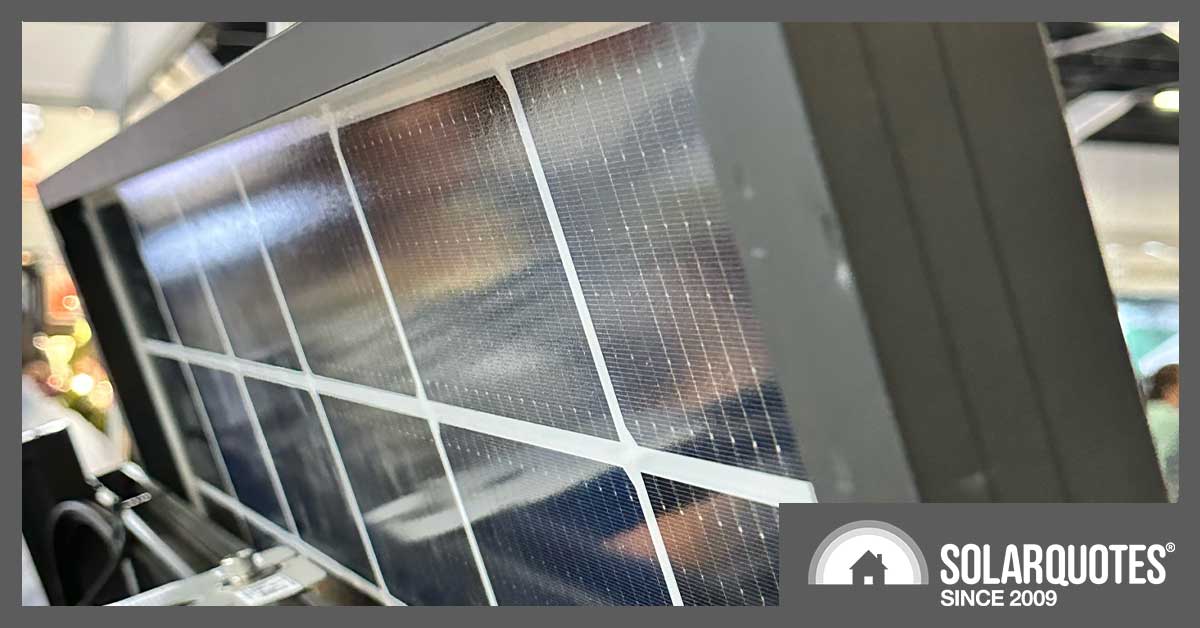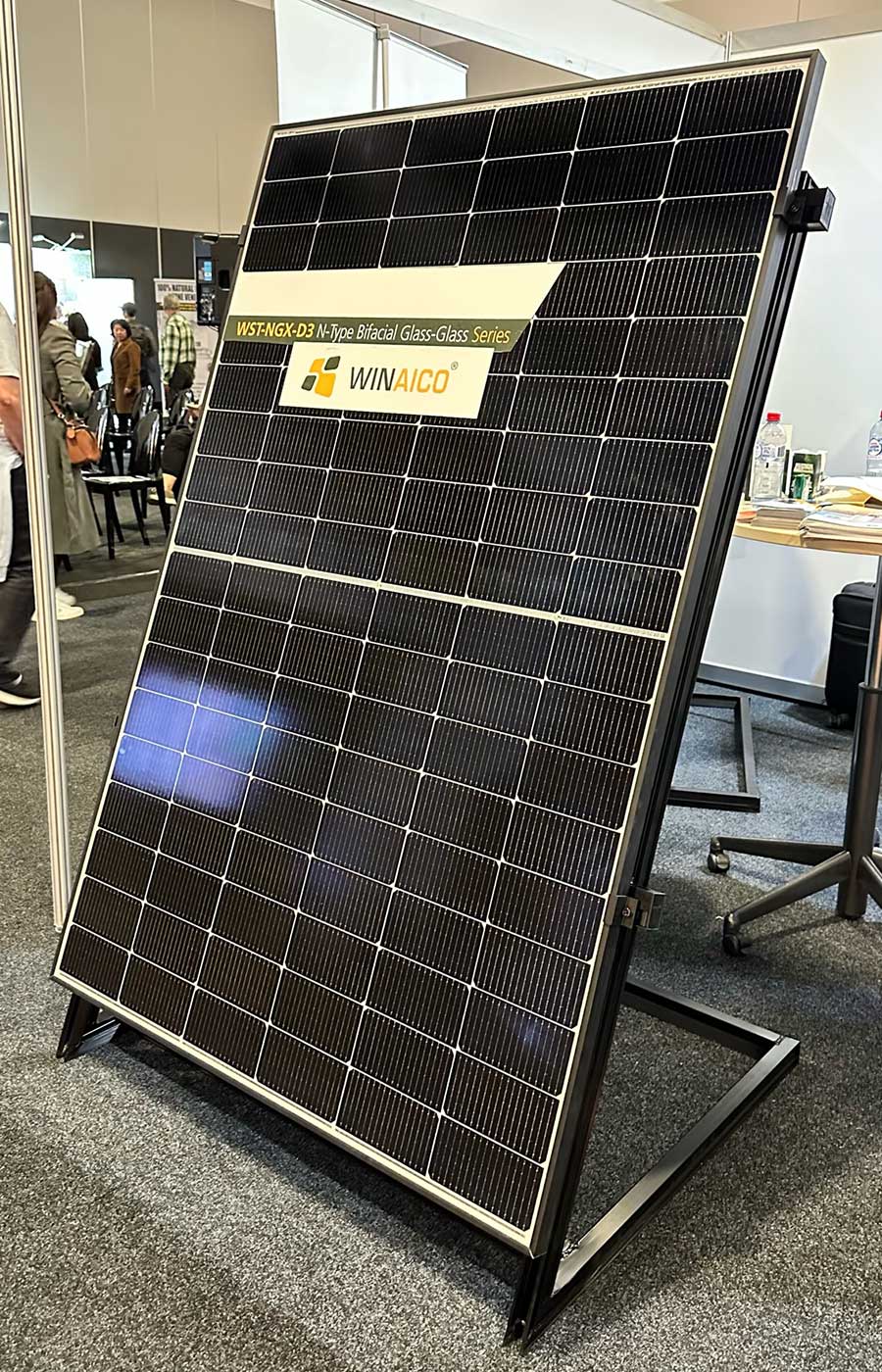
WINAICO will soon take orders for a range of high-yield panels offering up to 430 watts per unit.
The WST-NGX-D3 is a monocrystalline N-type bifacial glass-glass panel that offers a 30A maximum series fuse current, which sales director Blair Pester told SolarQuotes is “a win for the installers who are struggling with getting under the 600 volt rule for domestic”1
Technical note from SQ’s in-house installer, Anthony:
Modern split-cell solar panels are pushing ever higher currents. Combined with unique Australian rules which work against each other from the top and bottom of electrical design, our domestic solar PV installs aren’t just becoming inflexible and awkward; they’re downright difficult in some instances.
So with an artificially low 600VDC ceiling on grid connect systems plus 1.25 current multiplier rule, Winaico have picked up on the fact that more stings in parallel is a good answer for building larger systems, especially commercial ones at up to 1000VDC. To that end, they’ve gone to a pretty high 30amp fuse rating for the modules.
When you have panels in parallel you must consider what happens if there’s a fault. If one string is shorted then it has to be able to handle the energy from the adjacent one. Where it gets interesting is when you have more than 2 strings, the rules say you need to protect them from each other.
So if one string out of 3 develops a fault, the two others in parallel can supply 26.32amps, overwhelming the standard 20amp fuse rating on conventional modules. To prevent this from becoming a fire we are obliged to install fuses on every string. The problem is that then you need more parts, more labour and the added layer of complexity means you will have more failures.
The 30A fuse rating makes 3 parallel strings possible without adding fuses.
So all we need now is for inverter manufacturers to catch up in terms of current input. Unless you specify a commercial 3-phase inverter (15/20/30kW inverter or more) few will handle parallel arrays in any case. Bravo to Winaico for thinking ahead.
The module’s dimensions remain unchanged at 1,722mm x 1,134mm, we’re told, with the frame depth remaining at 35mm to ensure module strength and reliability. Reliability and performance are also supported by the framed glass-glass design with polyolefin elastomer (POE) as the encapsulant.

With an eye to the growth of micro-inverters and DC optimisers, the new modules include 1.2m cables.
The WST-NGX-D3 claims a module efficiency of 22.02%, but more importantly for Australian users, the temperature coefficients of -0.3% (maximum power), -0.25% (open circuit voltage) and 0.045% (short circuit current) “is going to improve performance in the warmer months and hotter climates”, Pester said.
After bumping its product and performance warranties from 15 years to 25 years in 2020, the new units up that again, to 30 years. As Michael pointed out when WINAICO launched its Gemini range, the product warranty is more important than the performance warranty, but that’s only an issue if they differ. There’s also the company’s usual complimentary two years of system insurance.
Pester told us: “For those of you who live in Sydney you will be able to see the very first modules that have been imported into the country at the Sydney Homes Show in Darling Harbour where a panel will be on display.”
Footnotes
- Pester explained to SolarQuotes that while AS5033:2021 allows a 1000V maximum system voltage, installers are caught by the inverter rule, AS/NZS 4777.1:2016, which limits inverter-connected systems to 600V. ↩

 RSS - Posts
RSS - Posts



It makes sense to run parallel strings to a solar combiner with separate fuses for each conductor of each string. Furthermore include a DC SPD and 2 pole isolation switch in the box. This way you can isolate each string to check each strings voltage without going on roof and manually disconnecting the parallel strings from each other . Having a SPD is good practice too.
Premium quality with our Winaico panels. They are fantastic and very high performing in summer and winter. A beautiful company with a fantastic ethos from Taiwan ??
Should probably add the fuses anyway. There needs to be a mandatory crowbar test to make sure this can be simulated.
Yes it is more labour, yes another connection to go bad, but just common sense.
The datasheet doesn’t say whether it’s Lead-Free, for potable rainwater collection. That’s essential for off-grid. (Still no reply from Tindo on theirs, either.) That’s a thing worth sorting out while planning.
I like the dimensions, efficiency, and, low derating with temperature.
I couldn’t see in the datasheet whether there are roof separation constraints on the bifacial boost effectiveness. My 70% albedo white roof ought to be good, I expect.
While no lead at all is best, the good news is there’s no real risk of solar panels contaminating drinking water with lead. Australia’s new standards that will apply in 2026 allows water pipes in your home to be 0.25% lead. One figure I have — that I’m not certain is correct — is that solar panels are 0.001% lead. The lead in a copper pipe is tightly bound to the copper but it is in direct contact with the drinking water, while the lead in a solar panel is in its solder and that should never come into contact with water. It’s covered in epoxy with a glass sheet on top that the rain falls on. All the lead that’s in a solar panel should still be there 30 years later.
Whilst EV Energy Stack technology will safely and predictably move up incrementaly to the 2000 – 3000 Volt level over time; exposed domestic rooftop PV Solutions at higher voltage is problematic and PV System Voltage limits have just about reached their commercially viable limit.
Ground mounted PV Solutions have different attributes hence opportunities to rooftop designs though, and can be expected in general to follow the EV System Voltage pathway.
Lawrence Coomber
Impressive move by WINAICO! The new 415W Gemini panels not only boost solar capacity but also ease compliance with Australia’s 600V rule. Kudos for innovation, making life simpler for installers Down Under.